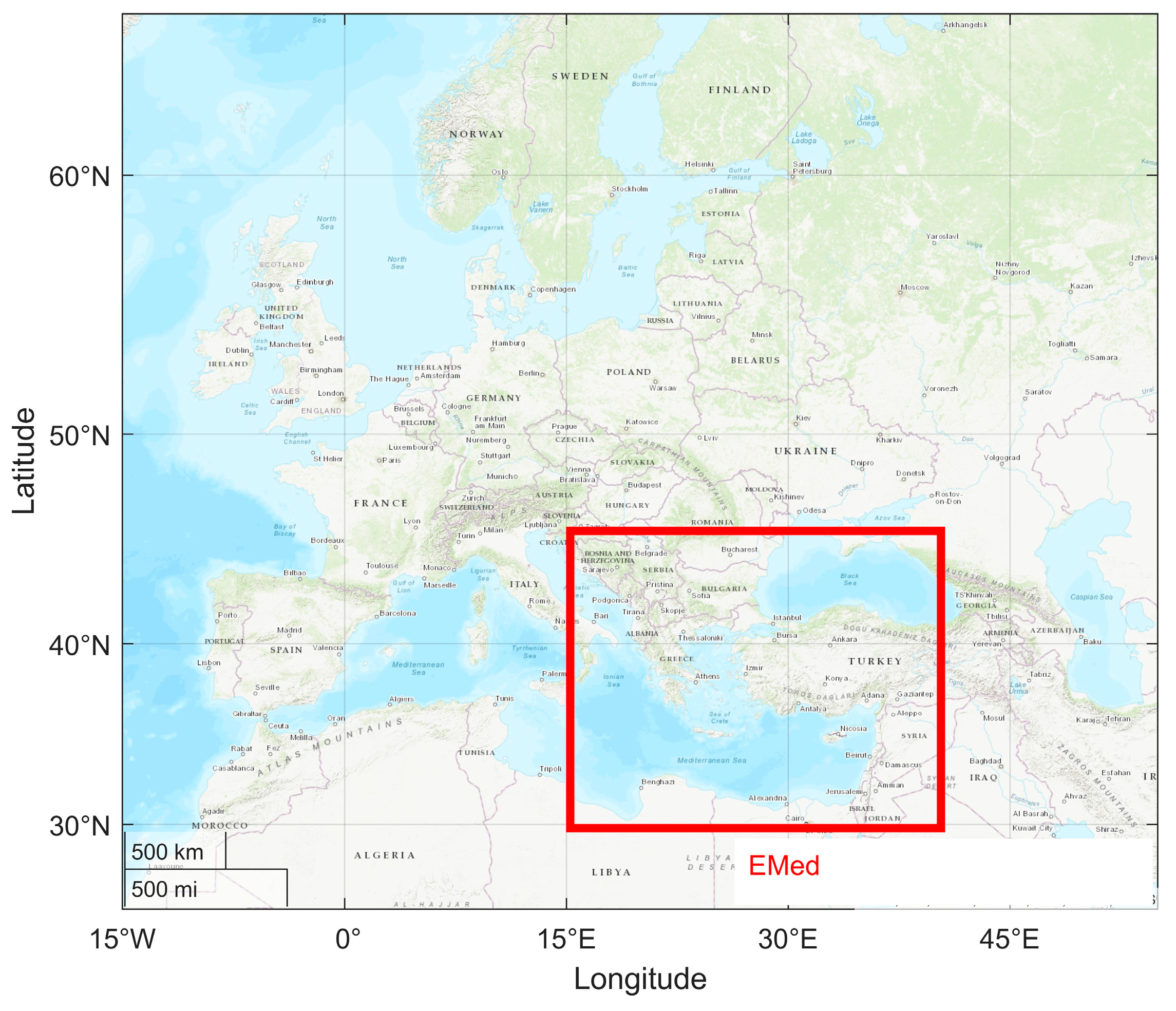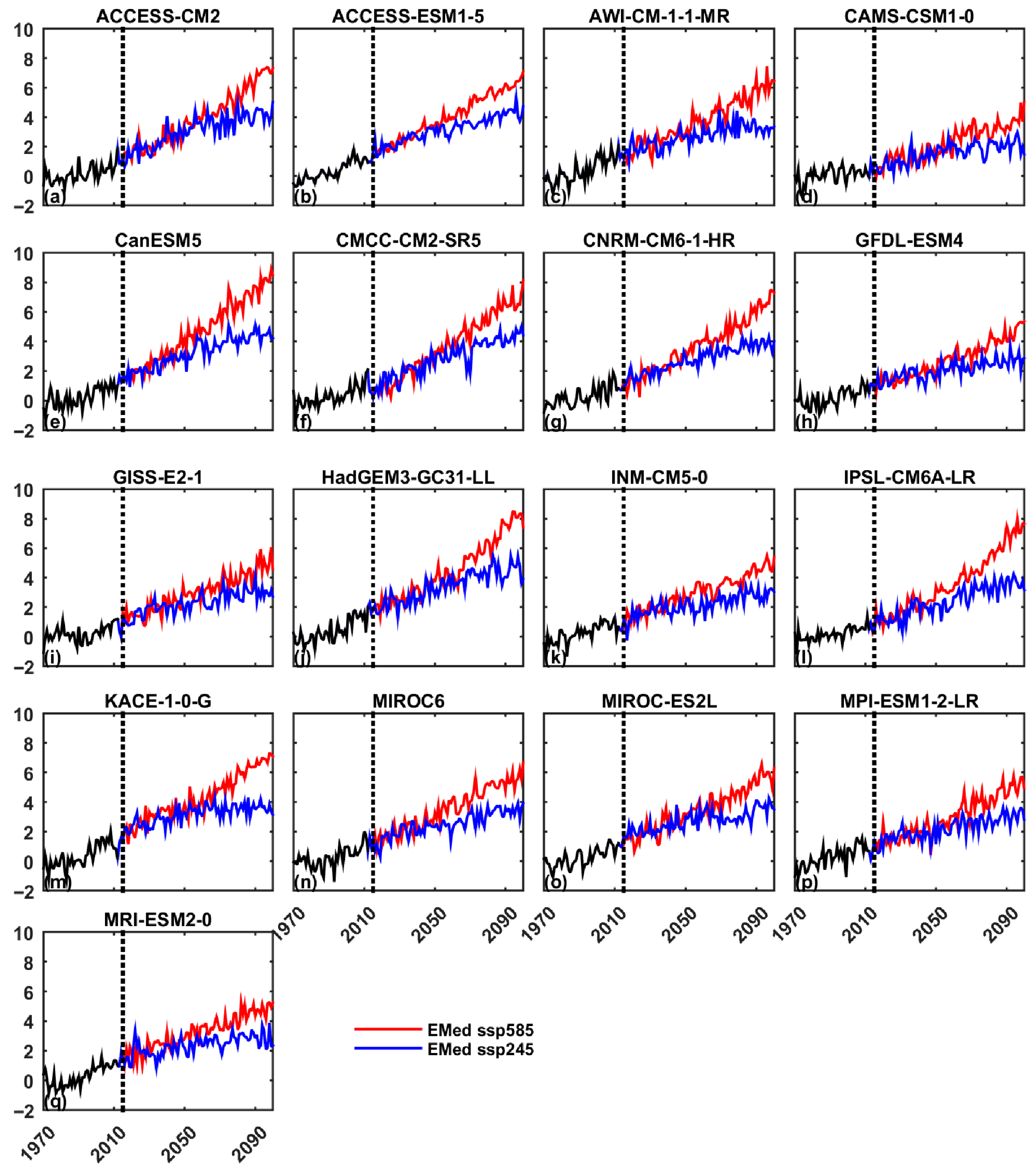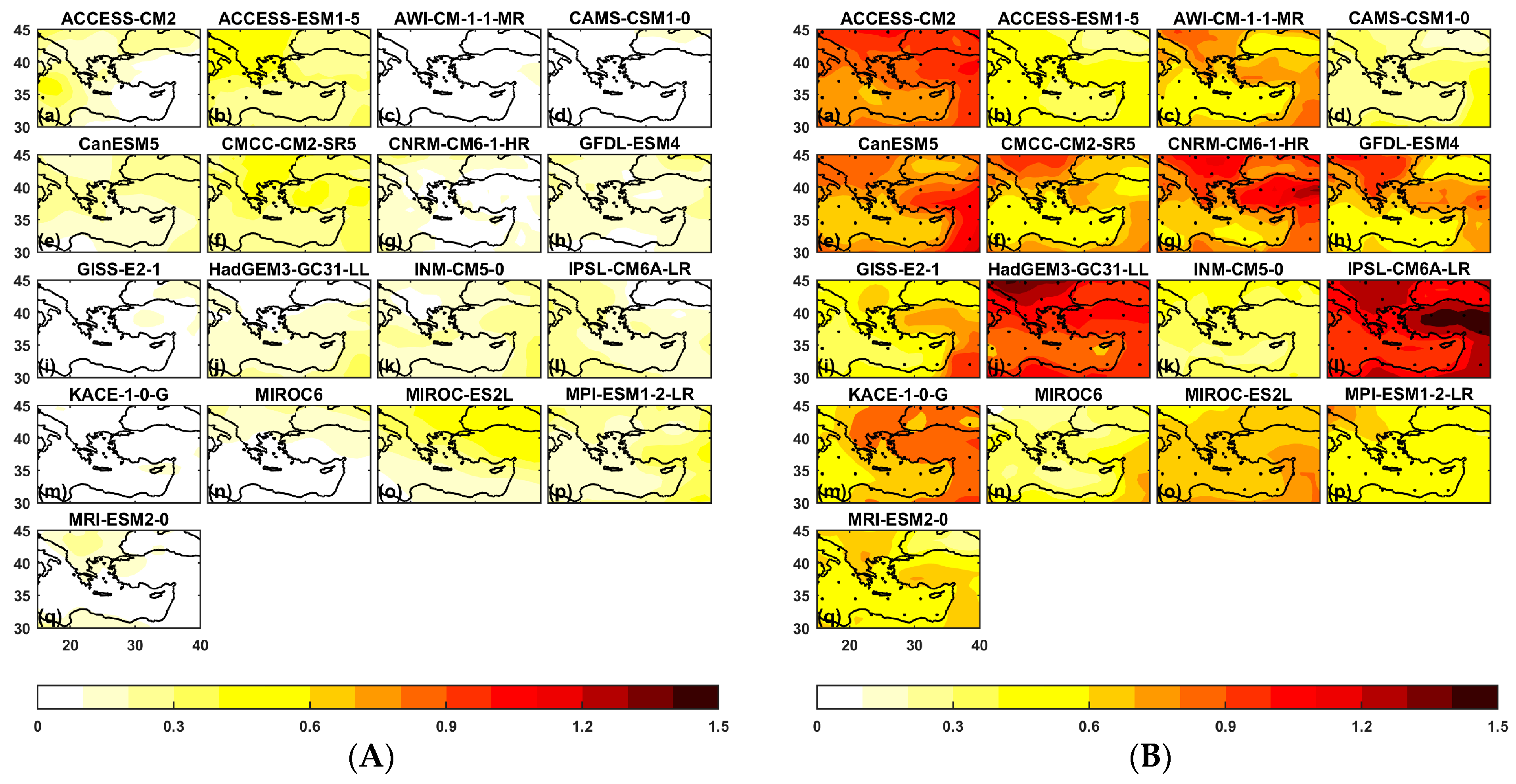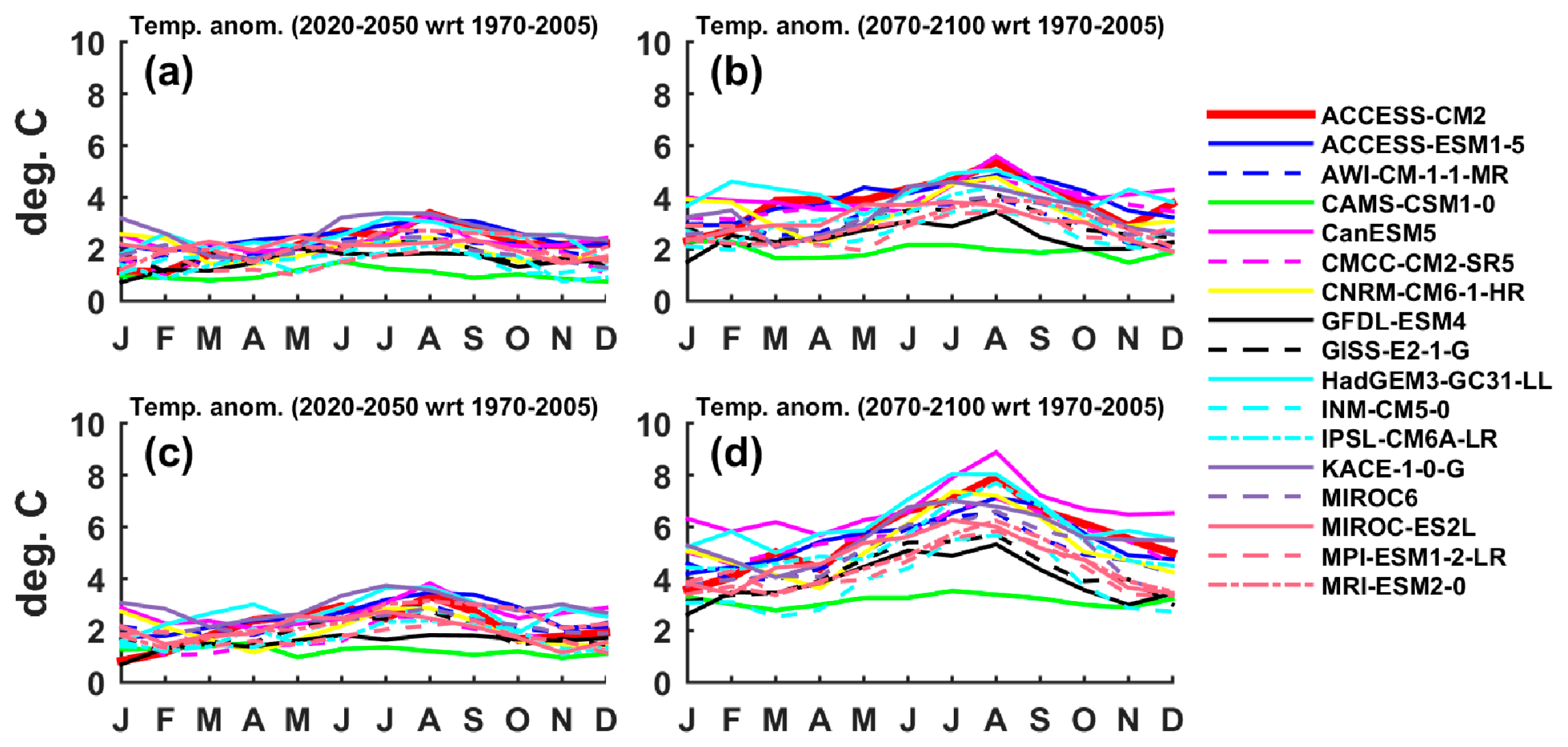Warming Projections of Eastern Mediterranean in CMIP6 Simulations According to SSP2-4.5 and SSP5-8.5 Scenarios †
Abstract
1. Introduction
2. Materials and Methods
2.1. Data and Region of Study
2.2. The Performance of CMIP6 Models to Simulate the Annual Mean Temperature Averaged over EMed
2.3. Temperature Projections and Trend Analysis over EMed: The Last Period of 21st Century
3. Results
3.1. Accuracy of CMIP6 Simulations to Capture and Reproduce the Annual Mean EMed Temperature
3.2. Future Temperature Changes over EMed
4. Conclusions
Author Contributions
Funding
Institutional Review Board Statement
Informed Consent Statement
Data Availability Statement
Acknowledgments
Conflicts of Interest
References
- Cos, J.; Francisco Doblas-Reyes, F.; Jury, M.; Marcos, R.; Bretonnière, P.A.; Samsó, M. The Mediterranean climate change hotspot in the CMIP5 and CMIP6 projections. Earth Syst. Dynam. 2022, 13, 321–340. [Google Scholar] [CrossRef]
- UN Environment Programme—The Mediterranean Action Plan (MAP)—Barcelona Convention. Available online: https://www.unep.org/unepmap/resources/factsheets/climate-change (accessed on 23 September 2024).
- Urdiales-Flores, D.; Zittis, G.; Hadjinicolaou, P.; Osipov, S.; Klingmüller, K.; Mihalopoulos, N.; Kanakidou, M.; Economou, T.; Lelieveld, J. Drivers of accelerated warming in Mediterranean climate-type regions. Npj Clim. Atmos. Sci. 2023, 6, 97. [Google Scholar] [CrossRef]
- Giorgi, F.; Lionello, P. Climate change projections for the Mediterranean region. Glob. Planet. Chang. 2008, 63, 90–104. [Google Scholar] [CrossRef]
- Zittis, G.; Almazroui, M.; Alpert, P.; Ciais, P.; Cramer, W.; Dahdal, Y.; Fnais, M.; Francis, D.; Hadjinicolaou, P.; Howari, F.; et al. Climate change and weather extremes in the Eastern Mediterranean and Middle East. Rev. Geophys. 2022, 60, e2021RG000762. [Google Scholar] [CrossRef]
- Carvalho, D.; Cardoso Pereira, S.; Rocha, A. Future surface temperatures over Europe according to CMIP6 climate projections: An analysis with original and bias-corrected data. Clim. Chang. 2021, 167, 10. [Google Scholar] [CrossRef]
- Eyring, V.; Bony, S.; Meehl, G.A.; Senior, C.A.; Stevens, B.; Stouffer, R.J.; Taylor, K.E. Overview of the Coupled Model Intercomparison Project Phase 6 (CMIP6) experimental design and organization. Geosci. Model Dev. 2016, 9, 1937–1958. [Google Scholar] [CrossRef]
- Hersbach, H.; Bell, B.; Berrisford, P.; Hirahara, S.; Horányi, A.; Muñoz-Sabater, J.; Nicolas, J.; Peubey, C.; Radu, R.; Schepers, D.; et al. The ERA5 global reanalysis. Q. J. R. Meteorol. Soc. 2020, 146, 1999–2049. [Google Scholar] [CrossRef]
- IPCC. Climate Change 2022: Climate Change 2022: Impacts, Adaptation, and Vulnerability. Contribution of Working Group II to the Sixth Assessment Report of the Intergovernmental Panel on Climate Change; Pörtner, H.-O., Roberts, D.C., Tignor, M., Poloczanska, E.S., Mintenbeck, K., Alegría, A., Craig, M., Langsdorf, S., Löschke, S., Möller, V., et al., Eds.; Cambridge University Press: Cambridge, UK; New York, NY, USA, 2022; 3056p. [Google Scholar]
- Riahi, K.; van Vuuren, D.P.; Kriegler, E.; Edmonds, J.; O’Neill, B.C.; Fujimori, S.; Bauer, N.; Calvin, K.; Dellink, R.; Fricko, O.; et al. The Shared Socioeconomic Pathways and their energy, land use, and greenhouse gas emissions implications: An overview. Glob. Environ. Chang. 2017, 42, 153–168. [Google Scholar] [CrossRef]
- Siabi, E.K.; Awafo, E.A.; Kabo-bah, A.T.; Derkyi, N.S.A.; Akpoti, K.; Mortey, E.M.; Yazdanie, M. Assessment of Shared Socioeconomic Pathway (SSP) climate scenarios and its impacts on the Greater Accra region. Urban Clim. 2023, 49, 101432. [Google Scholar] [CrossRef]
- Gupta, H.V.; Kling, H.; Yilmaz, K.K.; Martinez, G.F. Decomposition of the Mean Squared Error and NSE Performance Criteria: Implications for Improving Hydrological Modelling. J. Hydrol. 2009, 377, 80–91. [Google Scholar] [CrossRef]
- Zareian, M.; Dehban, H.; Gohari, A.; Haghighi, A.T. Assessment of CMIP6 models performance in simulation precipitation and temperature over Iran and surrounding regions. Environ. Monit. Assess. 2024, 196, 701. [Google Scholar] [CrossRef] [PubMed]
- Patil, S.D.; Stieglitz, M. Comparing spatial and temporal transferability of hydrological model parameters. J. Hydrol. 2015, 525, 409–417. [Google Scholar] [CrossRef]
- Tebaldi, C.; Debeire, K.; Eyring, V.; Fischer, E.; Fyfe, J.; Friedlingstein, P.; Knutti, R.; Lowe, J.; O’Neill, B.; Sanderson, B.; et al. Climate model projections from the Scenario Model Intercomparison Project (ScenarioMIP) of CMIP6. Earth Syst. Dynam. 2021, 12, 253–293. [Google Scholar] [CrossRef]
- Lelieveld, J.; Hadjinicolaou, P.; Kostopoulou, E.; Chenoweth, J.; El Maayar, M.; Giannakopoulos, C.; Hannides, C.; Lange, M.A.; Tanarhte, M.; Tyrlis, E.; et al. Climate change and impacts in the Eastern Mediterranean and the Middle East. Clim. Chang. 2012, 114, 667–687. [Google Scholar] [CrossRef] [PubMed]
- Almazroui, M.; Saeed, F.; Saeed, S.; Nazrul Islam, M.; Ismail, M.; Klutse, N.A.B.; Siddiqui, M.H. Projected Change in Temperature and Precipitation Over Africa from CMIP6. Earth Syst. Environ. 2020, 4, 455–475. [Google Scholar] [CrossRef]
- Rosselló, R.; Pascual, A.; Combes, V. Assessing marine heat waves in the Mediterranean Sea: A comparison of fixed and moving baseline methods. Front. Mar. Sci. 2023, 10, 1168368. [Google Scholar] [CrossRef]
- Evin, G.; Ribes, A.; Corre, L. Assessing CMIP6 uncertainties at global warming levels. Clim. Dyn. 2024, 62, 8057–8072. [Google Scholar] [CrossRef]
- Lionello, P.; Scarascia, L. The relation between climate change in the Mediterranean region and global warming. Reg. Environ. Chang. 2018, 18, 1481–1493. [Google Scholar] [CrossRef]







| Model | Institute (Country) | Resolution (lon/lat) | Ensemble |
|---|---|---|---|
| ACCESS-CM2 | Australian Community Climate and Earth System Simulator Climate Model Version 2 (Australia) | 192 × 144 | r1i1p1f1 |
| ACCESS-ESM1-5 | Australian Community Climate and Earth System Simulator Earth System Model Version 1.5 | 192 × 145 | r1i1p1f1, r2i1p1f1, r3i1p1f1 |
| AWI-CM-1-1-MR | Alfred Wegener Institute, Helmholtz Centre for Polar and Marine Research | 384 × 192 | r1i1p1f1 |
| CAMS-CSM1-0 | Climate Academy of Meteorological Sciences—Climate Simulation Model | 320 × 160 | r1i1p1f1 |
| CanESM5 | Canadian Centre for Climate Modelling and Analysis, Environment and Climate Change Canada | 128 × 64 | r1i1p1f1 |
| CMCC-CM2-SR5 | Fondazione Centro Euro-Mediterraneo sui Cambiamenti Climatici, Italy | 288 × 192 | r1i1p1f1 |
| CNRM-CM6-1-HR | Centre National de Recherches Meteorologiques, Centre Europeen de Recherche et de Formation Avancee en Calcul Scientifique, France | 256 × 128 | r1i1p1f2 |
| GFDL-ESM4 | National Oceanic and Atmospheric Administration, Geophysical Fluid Dynamics Laboratory, USA | 360 × 180 | r1i1p1f1 |
| GISS-E2-1-G | Goddard Institute for Space Studies, USA | 144 × 90 | r1i1p1f2 |
| HadGEM3-GC31-LL | Met Office Hadley Centre, UK | 92 × 144 | r1i1p1f3 |
| INM-CM5-0 | Institute for Numerical Mathematics, Russian Academy of Science, Russia | 180 × 120 | r1i1p1f1 |
| IPSL-CM6A-LR | Institut Pierre Simon Laplace, France | 144 × 143 | r2i1p1f1 |
| KACE-1-0-G | National Institute of Meteorological Sciences/Korea Meteorological Administration, Climate Research Division, Republic of Korea | 192 × 144 | r1i1p1f1 |
| MIROC6 | Japan Agency for Marine-Earth Science and Technology, The University of Tokyo, Japan | 256 × 128 | r1i1p1f1 |
| MIROC-ES2L | Japan Agency for Marine-Earth Science and Technology, The University of Tokyo, Japan | 128 × 64 | r1i1p1f1 |
| MPI-ESM1-2-LR | Max Planck Institute for Meteorology, Germany | 192 × 96 | r1i1p1f1 |
| MRI-ESM2-0 | Meteorological Research Institute, Japan | 128 × 64 | r1i1p1f1 |
Disclaimer/Publisher’s Note: The statements, opinions and data contained in all publications are solely those of the individual author(s) and contributor(s) and not of MDPI and/or the editor(s). MDPI and/or the editor(s) disclaim responsibility for any injury to people or property resulting from any ideas, methods, instructions or products referred to in the content. |
© 2025 by the authors. Licensee MDPI, Basel, Switzerland. This article is an open access article distributed under the terms and conditions of the Creative Commons Attribution (CC BY) license (https://creativecommons.org/licenses/by/4.0/).
Share and Cite
Logothetis, I.; Tourpali, K.; Melas, D. Warming Projections of Eastern Mediterranean in CMIP6 Simulations According to SSP2-4.5 and SSP5-8.5 Scenarios. Environ. Earth Sci. Proc. 2025, 34, 12. https://doi.org/10.3390/eesp2025034012
Logothetis I, Tourpali K, Melas D. Warming Projections of Eastern Mediterranean in CMIP6 Simulations According to SSP2-4.5 and SSP5-8.5 Scenarios. Environmental and Earth Sciences Proceedings. 2025; 34(1):12. https://doi.org/10.3390/eesp2025034012
Chicago/Turabian StyleLogothetis, Ioannis, Kleareti Tourpali, and Dimitrios Melas. 2025. "Warming Projections of Eastern Mediterranean in CMIP6 Simulations According to SSP2-4.5 and SSP5-8.5 Scenarios" Environmental and Earth Sciences Proceedings 34, no. 1: 12. https://doi.org/10.3390/eesp2025034012
APA StyleLogothetis, I., Tourpali, K., & Melas, D. (2025). Warming Projections of Eastern Mediterranean in CMIP6 Simulations According to SSP2-4.5 and SSP5-8.5 Scenarios. Environmental and Earth Sciences Proceedings, 34(1), 12. https://doi.org/10.3390/eesp2025034012







